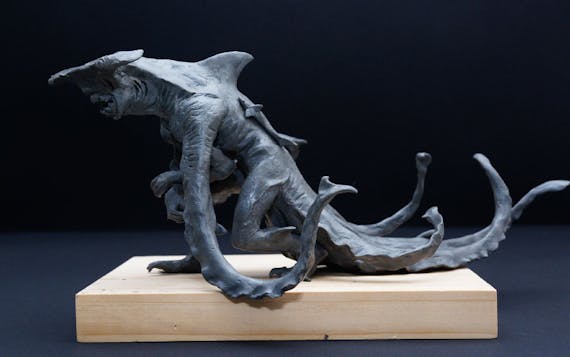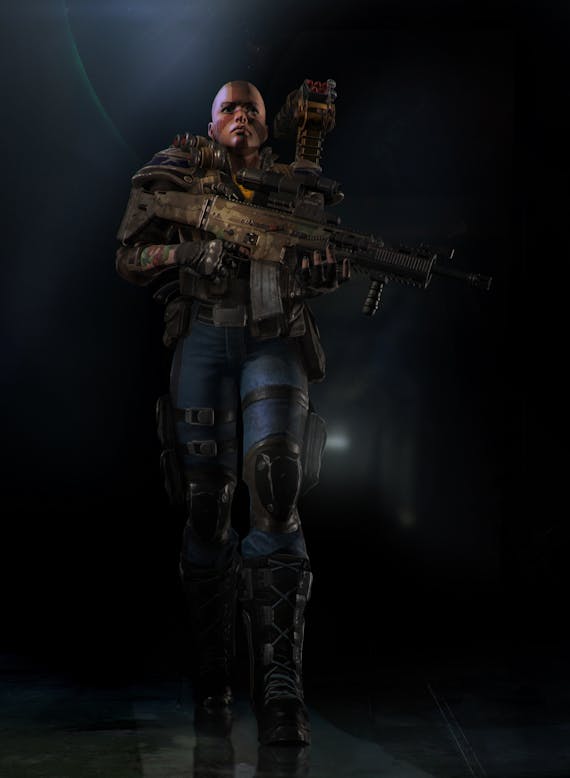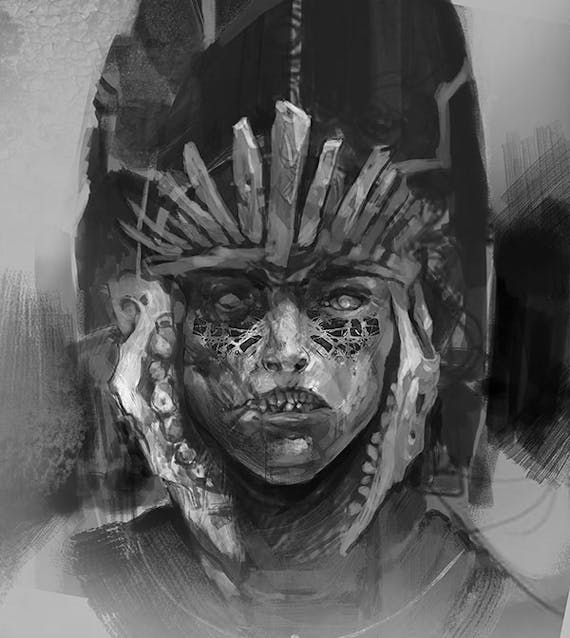Phoenix Point's Fig campaign promises new take on classic X-COM formula
Julian Gollop may have created the worst possible climate change timeline
Phoenix Point is the next game from Julian Gollop, the co-creator of the classic
X-COM: UFO Defense. His company, Snapshot Games, is launching
a $500,000 crowdfunding campaign today
on Fig. Gollop sat down with Polygon to talk about the inspiration for the game, and share new details on the ambitious, turn-based tactical strategy title expected by the end of 2018.
Phoenix Point is a post-apocalyptic game and the spiritual successor to Gollop’s branch of the X-COM franchise. While Firaxis Games XCOM series reboot took its inspiration from the 1994 original, Gollop’s game is more in line with his 1997 title called
X-COM: Apocalypse. The final product will of course include turn-based tactical battles and a geoscape-style world map, but also multiple human factions and battles against gigantic, city-sized aliens.
Phoenix Point will also have a fiction all its own.
TERROR FROM THE DEEP
In
Phoenix Point’s version of the future, Gollop tells us that the apocalypse began in the late 2020s. As the ice caps melted, the extraterrestrial Pandoravirus was released into the oceans where it immediately started attacking sea creatures of every shape and size. Before long, it had created hybrid monsters capable of crawling out onto the land. Humanity was caught off guard, and soon a deadly dark purple mist began creeping across the low-lying parts of the land.
It wasn’t just pollution. It was an airborne, microbial contaminant that also served as the network for the virus’ hive-mind. Those who couldn’t make it to higher ground were lost.
“Horrible mutations were going around,” Gollop said, “People were getting changed, while others just walked into the sea. The Pandoravirus’ genes had taken them over.”
The action in
Phoenix Point begins in 2057. Various factions of humanity have been pressed ever higher into the mountains in order to escape from the microbial cloud. Players take on the role of a leader within the mysterious Phoenix Project.
“It's basically a cell-based organization,” Gollop said, “which is international and stretches back in history. Most of the members of this organization are not even aware of each other, but once activated come together at Phoenix Point. They try to establish a base there over a number of years, but they have absolutely no contact with any of the other cells of the Phoenix Project. You know vaguely what the Phoenix Project is about ... but your personnel are operating under only the most basic instructions: Come together at this point and await further orders. But those orders never come.”
Early in the game, players will recover a helicopter to use for scavenging and reconnaissance. As powerful as the alien contagion is, it’s so far been unable to fly. With the Pandoravirus in control of the oceans and the player in control of the sky, the game’s many tactical battles will be a fought on land.
Concept art for Phoenix Point’s land-walking behemoths.
Snapshot Games
BIGGER THAN A BREADBOX
Gollop tells Polygon that
Phoenix Point will include combat against gargantuan, city-sized walking aliens.
“The land walkers are created by the aliens as a giant factory,” Gollop said, “producing energy, because the aliens are building something and you don't know what it is. Initially, they're just stomping across the land. They're just eating everything, and they're also used to attack human havens. So if they locate a haven, the land walker will head for it and they'll just try to eat everybody there and everything around it.
Cover art for
X-COM: Apocalypse, released in 1997.
MicroProse
“So the way you have to take these out is, you will actually land a squad on their backs — on the top — and try and drill through their armored carapace and deploy some poison in there to disable it, to take it down. So you'll actually be fighting a mission on top of a giant, moving creature which will be trying to get rid of you.”
The scale of the creatures is reminiscent of the kaiju-like enemy called the
Overspawn that harassed players in
X-COM: Apocalypse, and Gollop tells us that they are a very conscious attempt to capture the intended feeling of that game.
“
X-COM: Apocalypse is, from my point of view, like an unfinished project,” Gollop said. “Or, at least, a project only half done in the way that I really wanted it to be done. We wanted to bring back a sense of scale to our monsters.”
But these behemoths aren’t the only wrinkle in
Phoenix Point. There are also bus-sized boss monsters to deal with, like the crab queen.
A screenshot from an early build of the
Phoenix Point tactical game shows off the scale of the enemies players will be facing in combat.
Snapshot Games
The crab queen creates a number of tactical challenges for players. The most dangerous is the fact that it is capable of generating a microbial mist on its own. Troops who wander into it will be automatically detected, and alien enemies can be revived, buffed or otherwise driven into a deadly frenzy.
“It can also be used to cover,” Gollop said, “so the alien queen will actually start also producing larvae from its body which can run around and mutate directly into something hideous while you're trying to deal with it.”
Players will need to make the decision during combat about which of the queen’s systems it will attack, using an interface very similar to
Fallout’s VATs system
.
“When you're attacking a monster,” Gollop said, “you have to decide which body part you're aiming for. Are you trying to disable its legs? You trying to disable its head? Or you just trying to disable its mist generator? Or are you trying to disable the eggs inside which are hatching into these larvae? Or do you want to try and attack it under the belly?
Phoenix Point’s location-based damage model will extend to smaller units as well.
Snapshot Games
“You can actually walk under this monster and shoot up directly underneath it which, of course, is quite dangerous.”
Players will have all sorts of weapons systems to bring to bear in the game’s tactical battles, including drones, flamethrowers, chemical weapons and run-of-the-mill explosives. But it will take time to figure out what tools work best against which enemies. Combat will always be a compromise between players’ individual style and the limited resources they have at their disposal.
CLEVER GIRL
In combat, Gollop says that the Pandoravirus will be learning and adapting. Working from the tremendous amount of genetic material it has at its disposal, it will begin changing the main-line troops it sends after players in tactical battles. The humanoid-sized aliens players will face on the ground, Gollop said, will actually evolve over time.
“The aliens themselves, although they have intelligence, don't know exactly how to deal with the human threat,” Gollop said. “They don't necessarily understand you as a threat very well. So what they do is, if they have one of their mutations that’s just not doing very well against your forces and is getting his ass kicked, it will mutate in some way.”
The Pandoravirus consumes biological material for fuel and, as it moves into different regions, it will begin to create different kinds of mutated soldiers. Based on their performance in combat, the virus will recombine features semi-intelligently, making use of both physical and organic weapons systems to create entirely new troops. How those mutations perform in battle against your soldiers will simulate the process of natural selection, meaning that the virus will become a more deadly adversary over time.
“It's like the hermit crab,” Gollop said. “It doesn't build a shell of its own. It goes out and finds one. It has to steal one from somewhere else. That occurs a lot in nature and we decided, well, if the aliens really wanted to do something, why would they just rely on tentacles and stuff? If they can find guns, why don't they try and use them? If the aliens raid your base, they may take stuff. They may steal some technology, even if you've managed to repel them, and you might face some of your own weapons in the next battle.”
HIT THE BOOKS
Unlike previous X-COM games that Gollop has worked on, not everything in the
Phoenix Point research tree will come from the aliens. Many of the game’s more powerful weapon systems will come courtesy of the game’s other competing human factions. Players can try to ally with these other factions and get them to share their technologies, or they can take them by force.
“There will be three main factions in the game,” Gollop said. “They each have their own technology. It's like each of them has certain parts of the puzzle that could be put together to solve the alien problem. But, of course, they're jealously guarding their own secrets from each other.”
That also opens up the possibility of multiple resolutions to the alien threat, and multiple endings for the game.
“It also means that it's probably highly unlikely that in one campaign you will be able to get all the technology,” Gollop said. “In fact, you don't necessarily need it all because each of the three main factions does, in a way, have their own solution to the alien problem which you can use. You can literally opt for one of those three solutions that they're developing. They're all viable.”
The Fig platform allows for traditional, rewards-based funding as well as equity investment. The team at Snapshot Games is well-seasoned, Gollop said, and includes members from various Ubisoft and Crytek studios. Snapshot Games’ first title,
Chaos Reborn, was also the result of a successful crowdfunding campaign
on Kickstarter and reviewed well with critics.
Gollop said that he’s excited to bring the opportunity to invest in his team’s vision to X-COM fans. He said that his studio has invested around $450,000 in the project already. In addition to the $500,000 ask, $300,000 of which will be open to equity investors, his team will need at least another $100,000 to $150,000.
“We've been pretty conservative about our projections,” Gollop said. “As far as we're concerned, we can do the game if we get the $500,000. You have to bear in mind that development costs in Bulgaria [where Snapshot is based] are about a third that in the U.S.”
If the
Phoenix Point Fig campaign is successful, you can expect the finished game to come to Linux, Mac and Windows PC in late 2018.





























/cdn0.vox-cdn.com/uploads/chorus_asset/file/8397585/Concept_01_Behemoth.jpg)
/cdn0.vox-cdn.com/uploads/chorus_asset/file/8399803/apocalypse.jpg)
/cdn0.vox-cdn.com/uploads/chorus_asset/file/8397711/PhoenixPoint_Screen_03.jpg)
/cdn0.vox-cdn.com/uploads/chorus_asset/file/8397857/PhoenixPoint_Screen_02.jpg)


![The Year of Incline [2014] Codex 2014](/forums/smiles/campaign_tags/campaign_incline2014.png)











